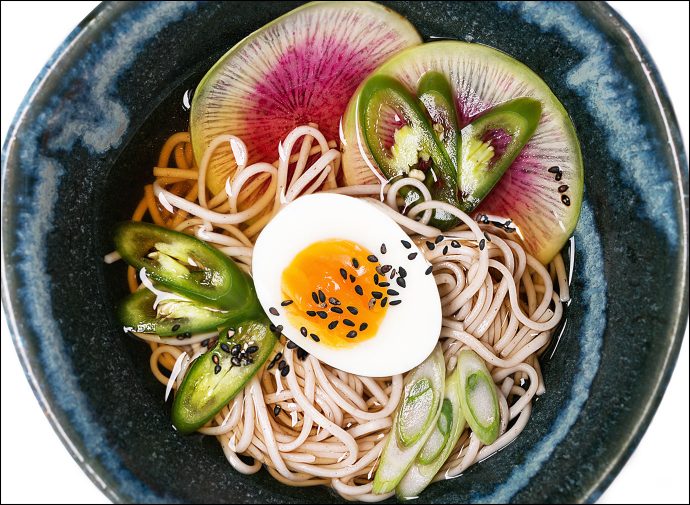Since I work from home these days, I can have a pot bubbling on the stove for hours. In the winter, I love ramen. I follow David Chang’s instructions for making the broth. Kombu (dried kelp) is first steeped in hot water and then removed. Next, dried shiitake mushrooms, chicken legs, meaty pork bones and smoky bacon are added in succession, along with scallions, onion and carrot. The whole process takes at least eight hours. The broth is strained and aggressively seasoned with Japanese tare sauce, which itself has been made from chicken bones or skin, simmered with sake, mirin and soy sauce.
The eagerly anticipated advent of spring calls for something different. This is an excellent season for soba noodles served in a light and flavorful broth, topped with scallions and chilies, pullet eggs, seared salmon, fresh herbs, or shavings of Meyer lemon rind, to name only a few good options.
I usually use farmed salmon, but for soba noodles to be a true celebration of this fleeting time of year, search for Northwest Spring Chinooks, or Spring Kings. It’s the first wild salmon that appears briefly in markets during early spring. Native Americans still annually hold First Salmon Ceremonies across the region, to pay tribute to this gift from the ocean. The fish’s flesh is deep red, with an orange undertone. When sprinkled with a little salt and seared, it is flavorful and rich.
Another way to celebrate is to top soba noodles with a pullet egg. A pullet is a hen that is under a year old. The most precious of pullet eggs are the first lay, which have the largest proportion of yolk to white, giving it both the densest proportion of nutrients and the best flavor. In Chicago, you can find this true springtime treasure at the end of winter farmer’s markets, just before the outdoor markets open on the first Saturday in May. When cooking pullet eggs, it’s best to steam them in the shell for 6 or 7 minutes — that’s the only way to peel them easily. If your eggs are very fresh, you can also garnish the boiling hot broth and noodles with a raw egg yolk.
I serve these noodles for breakfast, lunch or dinner. Sometimes I shop specifically for a noodle dish, with particular garnishes in mind, although I usually top the noodles with whatever bits of ingredients I have on hand. Here are two noodle dishes that I like, one garnished with a 6-minute egg, watermelon radish, scallion, and sesame seeds; the other garnished with seared salmon, salmon caviar, Meyer lemon rind, scallion, and Fresno chilies.


Fabulous!! And thanks for the reminder on steaming eggs. So excited to play with these flavors!
Can you believe I’ve never eaten soba? That will change now that I’ve read this article! The photo alone has me drooling. Your stories, recipes and photos bring the art of food to life beautifully! Thank you for awakening my senses.
Always good to remember to eat soba! So delicious and nourishing. And buckwheat is such a sustainable grain to grow! Yum!